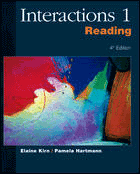 |  Interactions 1 Reading, 4e Elaine Kirn,
West Los Angeles College
Pamela Hartmann,
Los Angeles Unified School District
DiscussionsA. Using Discussion Strategies
There are a number of ways to use the discussion sections.
- Ask questions of the entire class. The advantage of this technique is that the teacher can control the discussion and encourage students to expand on their ideas. The disadvantage is that fewer students may volunteer to speak.
- Have students discuss the answers in small groups. A representative from each group can then report that group's ideas to the whole class. The reporting aspect is very important here, so make sure that all groups have a chance to share their ideas even if it means continuing the discussion in the next class.
- Have partners discuss. This technique helps shy students. However, it is best to combine pair discussions with small group work. Do this by asking each pair to share ideas with another pair. Then ask each small group to report.
You can have students practice their new vocabulary by asking them to choose four or five words that they will purposely use in their discussion or by assigning the whole class a set of words to use. Alternatively, you can assign a few different words to each group. Just make sure that the reporters use the words when they share their group's ideas.
B. Using Vocabulary Development Strategies
Vocabulary development is an important by-product of reading. Conversely, the more extensive one’s vocabulary, the more effective and enjoyable reading becomes. Encourage students to augment their vocabulary development by using some vocabulary-acquisition strategies.
- Learn opposites together.
- Learn synonyms and "near" synonyms of words they already know. Remember that there are few true synonyms, and students should be made aware of the subtle usage differences between words that appear to mean the same thing. For example thin, slim, and skinny are similar. However, thin is relatively neutral, slim is positive, and skinny is sometimes considered a negative term.
- Learn homophones. These are words with the same pronunciation but different spellings and meanings; for example, pear/pair, sweet/suite.
- Learn prefixes, roots, and suffixes.
- Learn categories of words together, for example, words that describe emotions.
- Learn collocations. Collocations are words that often occur together. For example, many verb + preposition combinations are collocations: graduate from, harmful to. Other examples are peace and quiet, peace of mind, and so on.
There are a number of ways to present the vocabulary explanations and exercises.
- Read the explanation aloud as students follow along in their books. Then have them paraphrase the main idea of what you read without looking at the words.
- Have students repeat or pronounce the examples, perhaps in response to brief meaning clues. For example, say, "Before you begin a class, you must enroll in it. In other words, you must complete your (blank)." The answer is enrollment.
- When you finish an exercise or group of related exercises, give a brief oral vocabulary quiz for review and reinforcement. For example, give students verbs and tell them to write related nouns.
- If appropriate, have students practice vocabulary they have just learned by using the words in sentences that illustrate their meanings. Remember that most nonnative speakers make vocabulary mistakes based on the usage of newly acquired words.
C. Vocabulary Notebook
You may want to have students keep a vocabulary notebook in which they write down the words that they feel will be useful. Optimally, each notation will contain part of speech, relevant definition, context sentence, and other related words. Examples are words that are morphologically connected (elation-elated), synonyms (joy-happiness), and antonyms (joy-sorrow). Let students draw in their notebooks or even write a native-language translation if they find it helpful. Periodically check their vocabulary notebooks for accuracy and completeness.
|
|



 2002 McGraw-Hill Higher Education
2002 McGraw-Hill Higher Education

 2002 McGraw-Hill Higher Education
2002 McGraw-Hill Higher Education